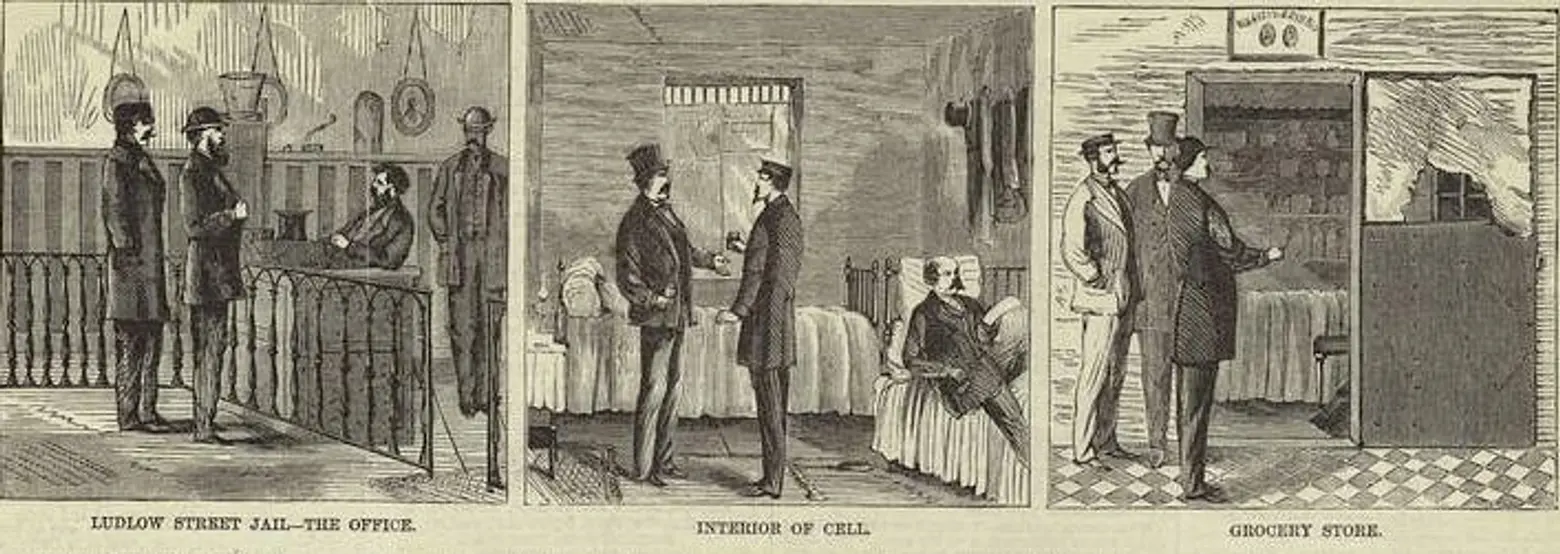In the 19th Century Men Who Didn’t Pay Alimony Went to the Ludlow Street Jail

Ludlow Street Jail (L) and men playing billiards inside (R), via NYPL
Public shaming of cheaters was around long before the Ashley Madison scandal. In fact, in the 19th century, men who divorced their wives and didn’t pay alimony were sent straight to jail.
Atlas Obscura uncovered the fascinating history of the Ludlow Street Jail, New York City’s federal prison on Ludlow and Broome Streets. Built in 1862, the jail mostly held debtors, but it also was where men who cheated on their alimony payments ended up, thus turning the “prison” into a glorified clubhouse for divorced men known as the New York Alimony Club. In addition to cigar smoking and unsavory jokes, the Ludlow Street Jail became known for back-door deals, rampant corruption, and the baffling semi-imprisonment of Boss Tweed.
William “Boss” Tweed, the notorious boss of Tammany Hall, helped found the jail, and he and a Board of Alderman oversaw the institution. The red brick building didn’t look much like a jail, with its large arched windows, stately cornice, and open courtyard. Inside, ten-foot square cells could hold 87 men. Only ten percent of the inmates committed federal crimes; the majority were there for owing money to creditors who convinced a judge they were a flight risk (formal debtors’ prison had been outlawed in 1833). And of course, there were the infamous divorcees.

A cartoon depicting the conditions at the jail, via NYPL
The divorced men would do exactly the things you’d expect a group of middle-aged single men to do–shoot pool, smoke, kvetch–as long as they coughed up money to the jail workers. They could even shop in a makeshift market called Hole in the Wall, which was set up in an empty cell. Many men actually surrendered to the prison just so they could live it up while still depriving their ex wives of alimony.
If this seems odd, it’s because the jail was full of corruption and scandal. As Atlas Obscura recounts:
In May of 1871, the New York Tribune arranged to have one of its reporters incarcerated in the Ludlow jail to check on some strange rumors about the facility. The reporter found that inmates were being offered better treatment and accommodations if they shelled out between $15 and $30 per week for the privilege. Inmates who couldn’t pay were trundled off to the top cramped top floors of the prison, where they were crammed into too-small cells where there often weren’t enough beds for everyone. Given that a huge majority of the inmates were dead-broke debtors, there was no way they could be expected to pay for this extortion.
 Boss Tweed (L); Cartoon of him with the caption “No prison is big enough to hold the boss.” via Library of Congress
Boss Tweed (L); Cartoon of him with the caption “No prison is big enough to hold the boss.” via Library of Congress
Around the same time, it came to light that Boss Tweed had scammed the city out of $200 million, and he was sent to Ludlow Street Jail as a prisoner. Of course, he received special treatment, paying $75 a week to live in the warden’s office and bedroom and take regular visits home. After failing to return from one of these visits, and eventually being recognized all the way in Spain, Tweed was put back in the jail, where he died of pneumonia in 1878.
Tweed’s death did nothing to stop the corruption, though, and by the turn of the century, almost all of the men in the jail were those who defaulted on alimony payments. The law dictated that by not paying one’s ex wife, he would spend six months in jail. So the general trend among divorced men was to not pay and then take an enjoyable trip to the New York Alimony Club. The jail became even more clubhouse-like; men were afforded holiday dinners, live music, and comfortable beds and didn’t even have to pay for it anymore. But by the 1920s, the novelty had worn off, and very few men remained in the Ludlow Street Jail. It was officially closed in 1927 and has since been replaced by the Seward Park Campus.
[Via Atlas Obscura]
RELATED:
































